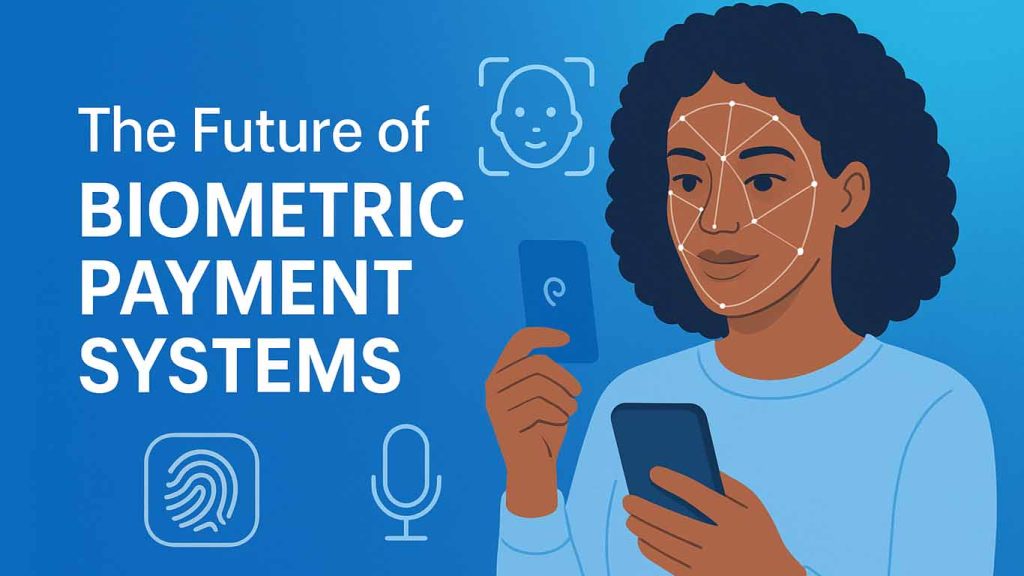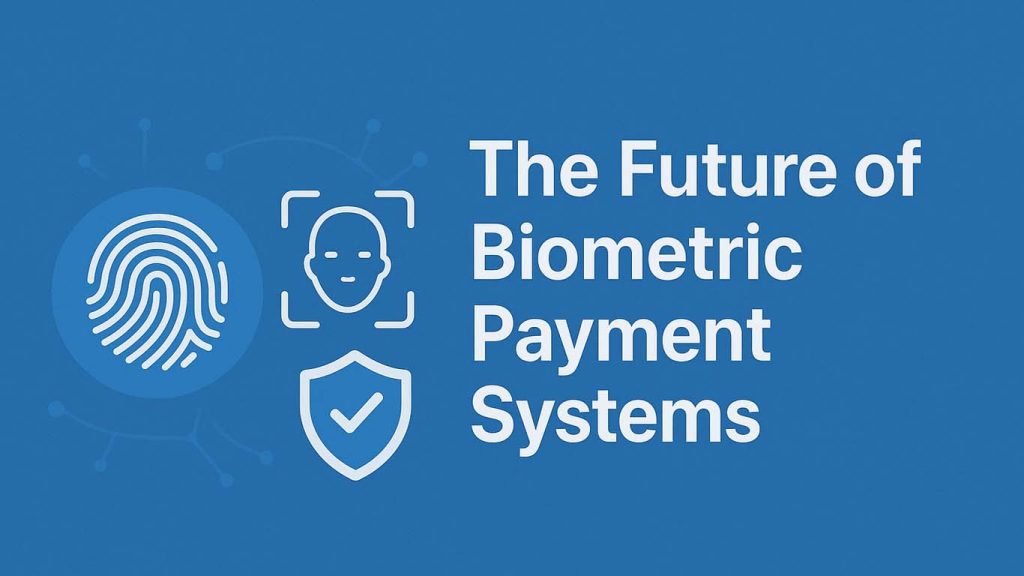
The Future of Biometric Payment Systems: Trends, Challenges, and Opportunities
Introduction
The payments industry is undergoing a dramatic transformation, with biometric payment systems rapidly emerging as a key driver of innovation in digital transactions. From unlocking smartphones with a fingerprint to paying for groceries through facial recognition, biometrics are redefining convenience, security, and personalization in financial interactions. As global economies embrace digital-first solutions, the use of biometric technology in payments is not just a futuristic idea but an increasingly mainstream reality.
By 2025 and beyond, biometric authentication is expected to become an integral part of secure and seamless financial transactions. According to Juniper Research, biometric payments will authenticate over 3 trillion transactions annually by 2027, signaling their pivotal role in the future of global commerce.
This blog explores the evolution, current applications, trends, and future developments of biometric payment systems, while also analyzing their opportunities and challenges.
What are Biometric Payment Systems?
Biometric payment systems use unique biological identifiers such as fingerprints, facial features, iris patterns, or even voice recognition to authenticate transactions. Instead of relying on traditional methods like passwords, PINs, or physical cards, these systems verify identity based on “who you are” rather than “what you know” or “what you have.”
Key Technologies Behind Biometric Payments
- Fingerprint Recognition
- Widely used in smartphones and ATMs.
- Offers speed and high accuracy.
- Facial Recognition
- Growing in popularity due to advanced AI-powered cameras.
- Used by Apple’s Face ID and retail checkout solutions.
- Iris and Retina Scanning
- Provides ultra-secure authentication.
- Mostly used in high-security financial systems.
- Voice Recognition
- Useful for call centers and remote banking verification.
- Behavioral Biometrics
- Tracks typing patterns, swipe gestures, or gait recognition.
- Adds an additional invisible layer of security.
Biometric payment systems combine these technologies with AI, machine learning, and blockchain to deliver secure, convenient, and fraud-resistant financial services.
Evolution of Biometric Payment Systems
The journey of biometric authentication in payments began in the early 2000s with fingerprint scanners integrated into laptops and specialized ATMs. However, it was the rise of smartphones that accelerated adoption. Apple Pay (2014) and Samsung Pay introduced biometric authentication, making it mainstream.
Today, biometric systems are used not only in mobile wallets but also in POS (Point-of-Sale) devices, ATMs, and e-commerce platforms. For instance:
- China leads adoption with facial recognition payments at retail chains like KFC.
- India integrates biometrics into its Aadhaar-based digital payment infrastructure.
- Europe and North America are adopting contactless biometric cards.
Current Trends in Biometric Payment Systems
1. Growing Consumer Acceptance
Consumers increasingly prefer biometrics because of convenience and speed. Surveys show that 67% of users feel comfortable using biometric authentication for payments compared to remembering multiple passwords.
2. Integration with AI and Machine Learning
AI-powered algorithms are making biometric recognition faster, more accurate, and resistant to fraud. For example, deep learning facial recognition ensures accuracy even in low-light environments.
3. Rise of Contactless Biometric Cards
Biometric-enabled credit/debit cards with fingerprint authentication are emerging, reducing the risk of fraud while maintaining convenience.
4. Security and Fraud Prevention
With global cybercrime expected to cost $10.5 trillion annually by 2025, biometric systems are being positioned as a defense mechanism against phishing, identity theft, and payment fraud.
5. Adoption in Developing Economies
Countries like India, Nigeria, and Brazil are using biometrics to support financial inclusion, enabling millions of unbanked citizens to access digital payments.
Benefits of Biometric Payment Systems
- Enhanced Security
- Biometric traits are unique and difficult to replicate.
- Reduces reliance on vulnerable passwords or PINs.
- User Convenience
- Faster checkout experiences with no need to carry cash or cards.
- Fraud Reduction
- Prevents identity theft and unauthorized access.
- Financial Inclusion
- Biometrics provide authentication for populations without formal ID or banking history.
- Cost-Effectiveness
- Cuts down fraud-related losses for financial institutions.

Limitations and Challenges
Despite their promise, biometric payment systems face several obstacles:
- Data Privacy Concerns
- Collection and storage of sensitive biometric data raises risks of misuse.
- High Implementation Costs
- Advanced biometric infrastructure can be expensive for banks and retailers.
- Accuracy Issues
- Facial recognition may fail in poor lighting; fingerprints may not work for manual laborers with worn prints.
- Algorithmic Bias
- Studies show facial recognition can have higher error rates for certain ethnicities and genders.
- Regulatory Gaps
- Lack of uniform standards for biometric data protection across countries.
Comparison with Traditional and Digital Payment Systems
- Traditional Payments (Cash & Cards)
- Lower privacy risk, but prone to theft and fraud.
- Less convenient in a digital-first economy.
- Digital Wallets (PayPal, Google Pay, etc.)
- Secure but still rely on PINs/passwords.
- Biometric systems remove these friction points.
- Biometric Payments
- Stronger security, faster authentication.
- Requires advanced infrastructure and strict privacy frameworks.
Biometric systems thus strike a balance between security and convenience, making them superior to traditional methods but dependent on proper implementation.
Future Developments in Biometric Payment Systems
1. Multimodal Biometrics
Future systems will combine multiple identifiers (e.g., fingerprint + voice) for layered security.
2. Blockchain Integration
Biometric data may be encrypted and stored on blockchain to prevent misuse.
3. AI-Powered Fraud Detection
Machine learning will analyze biometric patterns in real time to detect anomalies.
4. Biometric Wearables
Smartwatches and wearable devices may incorporate biometrics for seamless payments.
5. Cross-Border Adoption
Global standards may emerge, enabling biometric authentication across countries and platforms.
Case Studies and Real-World Examples
- China – Alipay and WeChat Pay
- Facial recognition terminals at retail stores enable customers to pay simply by smiling.
- India – Aadhaar Enabled Payment System (AEPS)
- Fingerprint-based biometric verification allows rural citizens to withdraw money and make payments without bank cards.
- Mastercard & Visa Biometric Cards
- Pilots in Europe show high user satisfaction with fingerprint-authenticated cards.
- US Banks
- JPMorgan and Wells Fargo are testing voice and facial recognition for secure mobile banking.
Ethical and Regulatory Considerations
- Data Ownership – Who owns biometric data: the user, government, or banks?
- Consent and Transparency – Users must know how their data is collected and used.
- GDPR and Global Regulations – Europe sets a benchmark for biometric data protection, but many countries lack clear frameworks.
- Bias and Inclusion – Ensuring biometric systems work equally well for all demographics is crucial.
Implications for Businesses and Consumers
- For Businesses:
- Reduced fraud losses, improved customer trust, and innovative branding.
- Must balance adoption costs with ROI.
- For Consumers:
- Greater convenience and faster transactions.
- Need to trust that their biometric data is secure.
- For the Global Economy:
- Could streamline international trade and cross-border payments.
- Supports the broader digital transformation of finance.
Conclusion
The future of biometric payment systems lies at the intersection of security, convenience, and innovation. While current adoption is strong, the next decade promises even more transformative developments, from multimodal biometrics to blockchain-based protection.
However, challenges like privacy, regulation, and cost must be addressed to ensure widespread trust and acceptance. Businesses that invest early in secure, user-friendly biometric payment solutions will likely emerge as leaders in the evolving digital economy.
For consumers, biometric payments represent not just a faster way to check out but a glimpse into a cashless, cardless, and password-free future.
